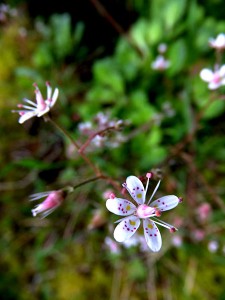When to Say ‘Pádraig,’ When to Say ‘Phádraig,’ and When to say ‘Saxifraga spathularis’ Posted by róislín on Mar 11, 2014 in Irish Language
(le Róislín)

Naomh Pádraig (photo of stained-glass window by Andreas F. Borchett, Kilbannon, http://en.wikipedia.org/wiki/File:Saxifraga_spathularis.jpg)
With Lá Fhéile Pádraig just around the corner, let’s take a closer look at the name “Pádraig” itself. It has two main forms, “Pádraig” being the basic form, and “Phádraig,” used in certain types of phrases. Less frequently, we may also encounter “bPádraig.” Of course, there are also nicknames, like Páidín, Páid, Padhra, Pat, Paudeen, and Paddy (but not ‘Patty’!). And there are also some variant spellings, like “Pádhraig,” “Pádhraic,” and “Pádraic.”
Whether to say ‘Pádraig‘ or ‘Phádraig‘ depends on the phrase involved. Here are some sample sentences (translations below, so new learners get a bit of a work-out):
Pádraig: the basic form:
Tá Pádraig anseo.
Cloisim Pádraig ag caint.
Is le Pádraig é seo.
Tá rothar ag Pádraig.
Phádraig: And now some examples with the “Phádraig” form:
“Dia dhuit, a Phádraig!”
Seo cóta Phádraig.
Tá caipín ar Phádraig.
Tabhair do Phádraig é.
bPádraig: And now the occasional use of “bPádraig,” most typically used in certain sentences that say what kind of person Pádraig is/was:
Fear deas atá i bPádraig.
Naomh a bhí i bPádraig Naofa ach saighdiúir agus iarla a bhí i bPádraig Sáirséal.
I suppose one might have reason to say:
Tá péist ribíneach i bPádraig.
or
Tá boiteog i bPádraig.
In those last two cases, áfach, I think one would be more likely to say, “Tá péist ribíneach i bputóga Phádraig,” or “Tá boiteog i gcraiceann Phádraig.” In either case, I’d add, “Feo!”
The first group has “Pádraig” as the subject, object, or object of certain prepositions. The second group, showing lenition (séimhiú), includes direct address (Hello, Patrick!), possession (the coat of Patrick), and certain prepositional phrases (here, ‘on Patrick’ and ‘to Patrick’). The third group, with eclipsis (urú) means “in Patrick,” here used with the idiom where “i” links two nouns (as in the pattern “Fear atá i Sean Connery ach bean atá i Sean Colvin). I should add “an t-amhránaí,” in case there are any fir reading this who are also named Sean Colvin.
These same changes would apply with the nickname forms and alternate spellings as well: “Bean Pháidín,” teach Pháid, “Dia dhuit, a Phádhraig,” “fear pósta atá i bPáidín” (agus sin é an fáth nach bhfuil an ban-aithriseoir san amhrán”Bean Pháidín” sásta nó leathshásta!).
And how about with the name “St. Patrick”? Well, for starters, in the phrase “Lá Fhéile Pádraig,” his name is generally left as is, not lenited (to “Phádraig“, which would normally be used for “Patrick’s”). I’ve always been told that this is a sign of special respect. If we were talking about an ordinary boy named Patrick, we’d say “breithlá Phádraig” (no”féile” possible since our hypothetical ordinary Patrick isn’t a saint). Other usages of “Pádraig” the saint, though, often do show lenition (séimhiú), as in “Cruach Phádraig” (Croagh Patrick) and “Purgadóir Phádraig” (St. Patrick’s Purgatory). But there are exceptions, such as the various schools named “Scoil Pádraig Naofa.”

Cabáiste an Mhadra Rua aka St. Patrick’s Cabbage, Fox Cabbage, and London Pride (nasc ag deireadh an ailt)
As for “Saxifraga spathularis,” it’s the Latin name for a plant called ‘St. Patrick’s Cabbage.” But lo, and behold, the Irish name for this plant isn’t based on the name ‘Patrick’ at all. It’s “cabáiste an mhadra rua.” And lo (faoi dhó) agus behold (faoi dhó), this plant has (at least) two other names in English, “London Pride” and “fox cabbage.” The latter is not surprising, since “madra rua” means “fox,” or more literally “coppery red-furred dog” (that “coppery” bit is so you don’t think we’re talking “Clifford red”). A literal translation as “red dog” could lead us merrily up a garden path where we might end up among the dog roses, dog fennel, dog bane, or dogwoods. So we’ll stop with “fox cabbage,” and with me brushing up on my Noel Coward and Mary Elizabeth Braddon. Erm, why Noel Coward? 1941 — “London Pride” is a flower that’s free.” Why Mary Elizabeth Braddon? Her 1896 novel, London Pride. And why don’t we have a song or novel called “Fox Cabbage.” Maybe that title just doesn’t have that special panache!
And actually, these plant names, as with other plant name in other blogs in this series, create a complex web of species, sub-species, and vernacular terms, but I’ll simply accept that “London Pride” is another name for “St. Patrick’s Cabbage,” at least for present purposes. I wonder if it’s edible, but the accounts I’ve found of it online give no indication of edibility.
Speaking of edibility, and always harboring in the back of my mind a recollection of Leopold Bloom’s breakfast in Joyce’s Ulysses, I was struck by the name of another member of the Saxifraga genus, the “Kidney Saxifrage,” with “Saxifraga hirsuta” as its Latin moniker (“hirsuta” – hairy, wow!). Hmm, curiouser and curiouser but no evidence that “Kidney Saxifrage” is edible either. All the more “curiouser” when one considers that “saxifrage” itself means “rock-breaker.” Useful for kidney stones, I wonder? Actually I doubt it. I believe the plant grows a lot on stone walls and finds cracks and crevices in which to root, ultimately, perhaps, compromising the stone walls’ durability. In Irish, this one is “mórán giobach,” lit. “shaggy saxifrage,” with no reference to kidneys. Most types of saxifrage are referred to in Irish as “mórán,” which appears to have no relationship to the more well known word “mórán” meaning “much” or “many.”
A little online research tells me that Pliny the Elder believed that Kidney Saxifrage could cure gallstones (why not kidney stones?). So I guess I’m jumping into the saxifrage applications game about 2000 years after the fact, but, bhuel, “Is fearr déanach ná riamh.” And even if we can’t consume “St. Patrick’s Cabbage,” with the “mairteoil shaillte,” at least in the US, it adds a new dimension to St. Patrick-related vocabulary. Bain sult as an bhféile – Róislín
Aistriúchán:
a) Pádraig: Tá Pádraig anseo. Patrick is here; Cloisim Pádraig ag caint. I hear Patrick speaking; Is le Pádraig é seo; This is Patrick’s; Tá rothar ag Pádraig. Patrick has a bicycle.
b) Phádraig: “Dia dhuit, a Phádraig!”, “Hello, Patrick!”; Seo cóta Phádraig. This is Patrick’s coat; Tá caipín ar Phádraig. Patrick is wearing a cap, lit. there is a cap on Patrick; Tabhair do Phádraig é. Give it to Patrick.
c) bPádraig: Fear deas atá i bPádraig. Patrick is a nice man; Naomh a bhí i bPádraig Naofa ach saighdiúir agus iarla a bhí i bPádraig Sáirséal. Holy (Saint) Patrick was a saint but Patrick Sarsfield was a soldier and an earl; Tá péist ribíneach i bPádraig. There is a tape-worm in Patrick; Tá boiteog i bPádraig. There is a bot-fly in Patrick. Like I said above, “Feo!” (Ugh!)

Build vocabulary, practice pronunciation, and more with Transparent Language Online. Available anytime, anywhere, on any device.




Comments:
Gurrier:
Go raibh míle maith agat as an mblog spéisiúil – chas mé ar um deire seachtaine seo caite, díreach in am dosna píosaí tráthúla seo. Táim ag tnúth le tuile um Luan!
róislín:
@Gurrier Go raibh maith agat, a Gurrier. Tá áthas orm gur bhain tú sult as! Agus tá tuilleadh ag teacht!
Maidir le d’ainm, is dócha gur maith leat cístí ‘gur.’ Fíor?
Margaret Mac:
Thank you very much for your wonderful blog and all the trouble you go to. I would give anything to be able to speak Irish as you can but your blog truly motivates me to keep going. I can make out most of the basic stuff but I am glad you are doing a translation at the end for anything I am not sure of.Now I know the Irish for tapeworm!. Would you mind if I made a suggestion?. I would love stuff on traditional things, marriage customs, songs etc etc. Not so fussed about the Gaelic for computers etc.
róislín:
@Margaret Mac A Mháiréad, a chara (or if you prefer the more traditional spelling, “A Mhaighréad”),
Thank you for your kind comments and suggestions. Re: tape-worm, you might also be interested to know that the word ribíneach, which distinguishes péisteanna ribíneacha from other types of péisteanna, such as péisteanna talún, has the basic meaning of “ribboned” or “ribbon-like.” It’s based, as one might expect on “ribín,” the ordinary word for ribbon. As for weddings and other traditions, we can certainly include more of that in the future. For right now, though, it might interest you to know that “bainis” (wedding, wedding-feast) is from the compound word “bain-fheis,” the same “Feis” we know today for music and dance. Since the “fh” was silent, it was removed during the spelling reform, although you may still see it sometimes today. As for “feis” itself, it originally meant not just “festival,” as we usually use it today but also “marriage,” and, well, umm, related topics. And that intrigue should keep our readers engaged!